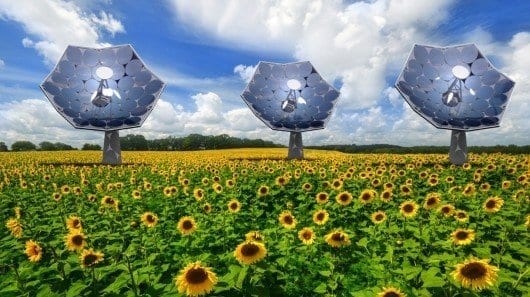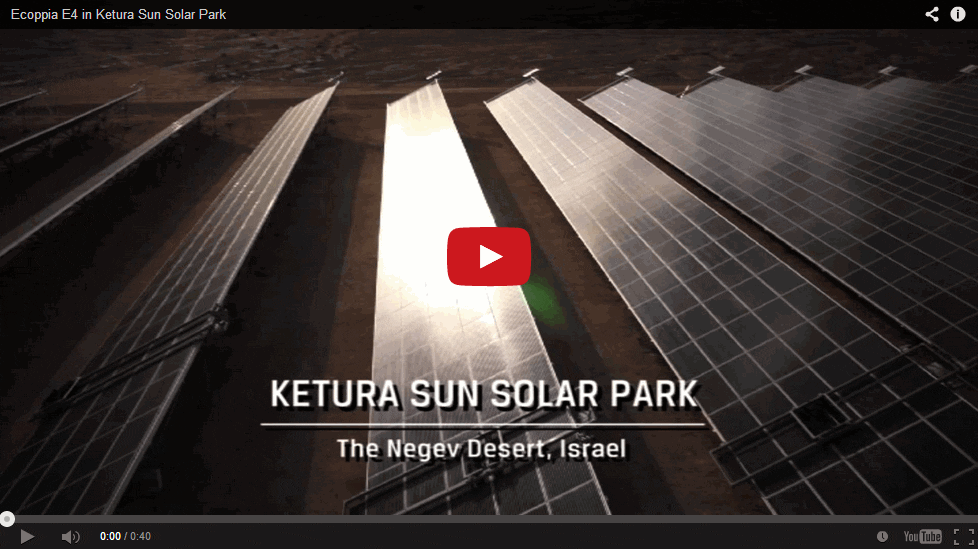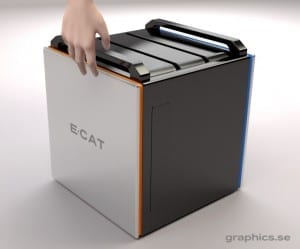
Click on this picture for VIDEO
Using a number of liquid-cooled microchannel receivers, each equipped with an array of multi-junction photovoltaic chips, each HCPVT can produce enough power, water, and cooling to supply several homes.
Looking rather like a 10-meter (33 ft) tall sunflower, IBM’s High Concentration PhotoVoltaic Thermal (HCPVT) system concentrates the sun’s radiation over 2,000 times on a single point and then transforms 80 percent of that into usable energy.
Using a number of liquid-cooled microchannel receivers, each equipped with an array of multi-junction photovoltaic chips, each HCPVT can produce enough power, water, and cooling to supply several homes.
Swiss-based supplier of solar power technology, Airlight Energy, has partnered with IBM Research to utilize IBM’s direct wam-water cooling design (adapted from use in IBM’s SuperMUC supercomputer), water adsorption technologies, and leverage IBM’s past work with multi-chip solar receivers developed in a collaboration between IBM and the Egypt Nanotechnology Research Center, to develop and produce the system.
Using a 40-sq-m (430.5-sq-ft) parabolic dish coated with 36 plastic foil elliptic mirrors just 0.2 mm thick, the HCPVT system prototype concentrates the sun’s radiation onto a number of liquid-cooled receivers, each of which contains an array of 1×1-cm2 (0.39 × 0.39 in2) chips that each generate “up to 57 watts of electrical power when operating during a typical sunny day.” Combined, the whole system produces a total of 12 kW of electrical power and 20 kW of heat over that same period.
Micro-structured conduits pump treated water around these receivers to carry away excess heat at a rate that is claimed to be 10 times more effective than passive air cooling. Although the water is still subsequently heated to around 85-90° C (183-194° F), the removal of heat from the chips keeps them at a relatively cool safe operating temperature of around 105° C (221° F). Without this cooling, the concentrated energy of the sun would see the chips reach temperatures of over 1,500° C (2,732° F).
“The direct cooling technology with very small pumping power used to cool the photovoltaic chips with water is inspired by the hierarchical branched blood supply system of the human body,” said Dr. Bruno Michel, manager, advanced thermal packaging at IBM Research.
The HCPVT system can also be adapted to use the cooling system to provide drinkable water and air conditioning from the hot water output produced. Salt water is passed through the heating conduits before being run through a permeable membrane distillation system, where it is then evaporated and desalinated. To produce cool air for the home, the waste heat can be run through an adsorption chiller, which is an evaporator/condenser heat exchanger that uses water, rather than other chemicals, as the refrigerant medium.
The creators claim that this system adaptation could provide up to 40 liters (10 gallons) of drinkable water per square meter of receiver area per day, with a large, multi-dish installation theoretically able to provide enough water for an entire small town.
All of these factors, – waste energy used for distillation and air-conditioning combined with a 25 percent yield on solar power – along with the setup’s sun tracking system that continuously positions the dish at the best angle throughout the day, combine to produce the claimed 80 percent energy efficiency.
The Latest on: High Concentration PhotoVoltaic Thermal
[google_news title=”” keyword=”High Concentration PhotoVoltaic Thermal” num_posts=”10″ blurb_length=”0″ show_thumb=”left”]
via Google News
The Latest on: High Concentration PhotoVoltaic Thermal
- Thermal Battery Solar Technology Soon to Rapidly Deliver On-site Power Generation for Data Centerson April 26, 2024 at 3:25 pm
Exowatt has announced a new type of self-contained solar power generation, set to be available at scale later this year.
- Solar-assisted thermochemical heat pump based on caustic soda, wateron April 26, 2024 at 1:01 am
Researchers in China have designed a two-stage, solar-assisted thermochemical heat pump system that uses caustic soda and water as a working pair. The system is reportedly able to achieve an energy ...
- Reducing photovoltaic-thermal module temperature with iron, copper oxideon April 25, 2024 at 4:57 am
An international research team has proposed using iron oxide and copper oxide to lower photovoltaic-thermal (PVT) solar module temperature. Their analysis showed that the two compounds were able to ...
- Concomitant Ceftriaxone and High-concentration Intravenous Calcium Therapy in Adult Critical Care Patients: A Matched Cohort Studyon April 23, 2024 at 5:00 pm
Nevertheless, these were high-risk patients in a highly monitored setting receiving high concentrations of calcium while on ceftriaxone; therefore, our results should offer reassurance to ...
- Aerogel-based phase change materials improve thermal management, reduce microwave emissions in electronic deviceson April 23, 2024 at 9:25 am
Electronic devices are getting more and more complex as they are built to carry out an ever-increasing number of functions. This can be seen in the increased functionality in our personal devices such ...
- Best Solar Panels For Homes Of 2024on April 23, 2024 at 1:08 am
Making a move to equip your home with solar energy solutions has never been easier. Solar tax credits and rebates designed to reward solar power adopters are readily available as the renewable ...
- Advancing performance assessment of a spectral beam splitting hybrid PV/T system with water-based SiO₂ nanofluidon April 18, 2024 at 11:22 am
As the globe grapples with the urgent need to shift from fossil fuels to sustainable energy sources, solar power stands as a beacon of hope. However, a significant challenge has been to efficiently ...
- Crypto trading concentration a 'considerable concern', EU watchdog sayson April 10, 2024 at 12:43 pm
LONDON, April 10 (Reuters) - The high concentration in crypto trading on a handful of exchanges, with Binance alone accounting for about half the market, raises concerns about the impact of a ...
- Mismatch voltage & thermal patterns in half-cell bifacial technologyon April 7, 2024 at 5:00 pm
The study focuses on inducing hotspots using a type of textile to observe the thermal behaviour across different parts of the photovoltaic module under varying levels of irradiance. The hotspot ...
- Best high dividend ETFs of April 2024on April 1, 2024 at 5:00 pm
Please view our full advertiser disclosure policy. Vanguard High Dividend Yield ETF (VYM) offers dividend investors a straightforward, affordable and accessible way of accessing U.S.-listed high ...
via Bing News










